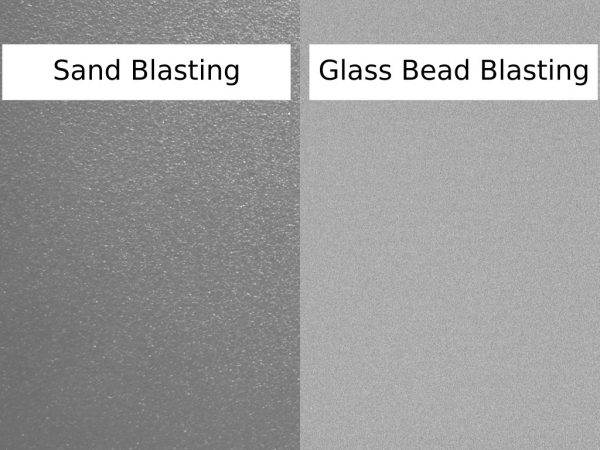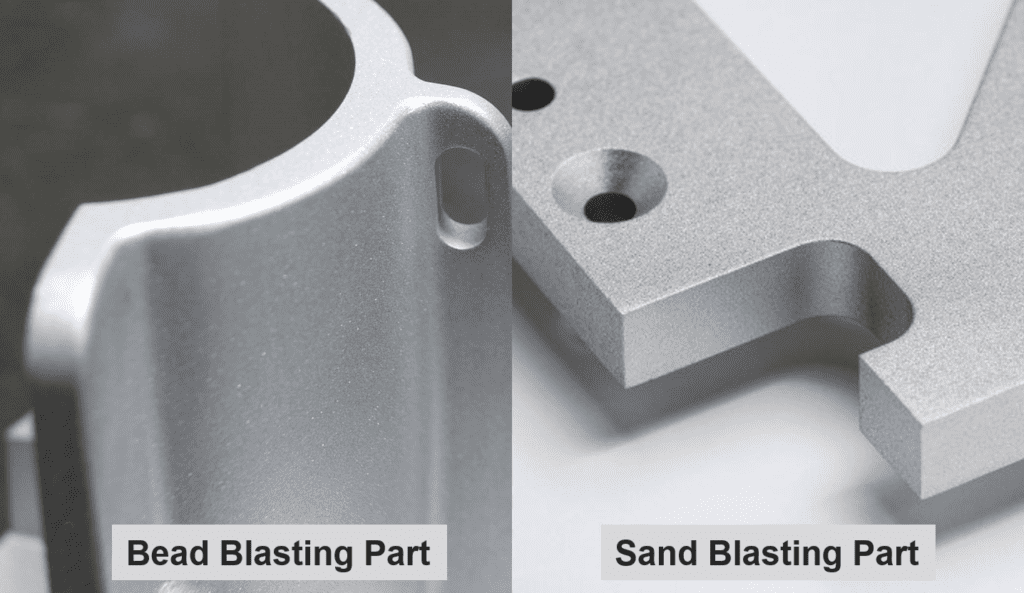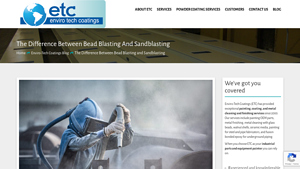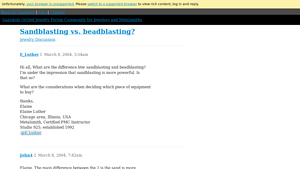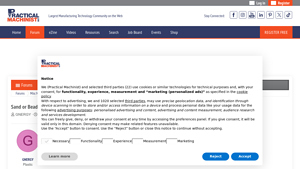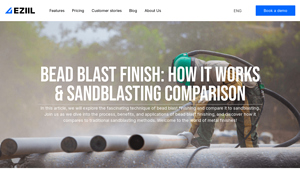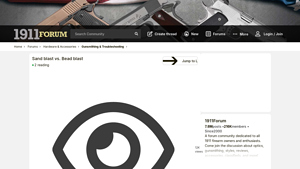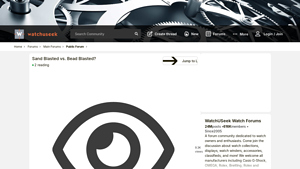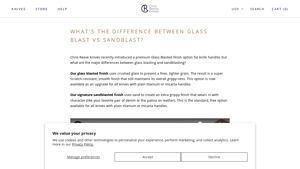Bead Blasting Vs Sand Blasting Guide: Type, Cost, Top List…
Introduction: Navigating the Global Market for bead blasting vs sand blasting
In the competitive landscape of surface preparation, understanding the nuances between bead blasting and sand blasting is essential for B2B buyers looking to optimize their operations. Sourcing effective surface treatment solutions can be challenging, particularly when considering factors like material compatibility, application requirements, and cost-efficiency. This comprehensive guide delves into the critical differences between these two abrasive blasting methods, equipping international buyers from regions such as Africa, South America, the Middle East, and Europe—including Nigeria and Germany—with the insights necessary to make informed purchasing decisions.
Throughout this guide, we will explore the distinct characteristics of bead blasting and sand blasting, highlighting their respective applications in various industries, from automotive to aerospace. Buyers will gain valuable information on selecting the right method based on project specifications, the types of materials involved, and the desired finish. Furthermore, we will discuss key considerations for supplier vetting, including safety standards, regulatory compliance, and technological capabilities, ensuring that your sourcing process aligns with global best practices. By the end of this guide, you will be empowered to navigate the complexities of the global market, making strategic decisions that enhance both performance and profitability in your surface preparation initiatives.
Understanding bead blasting vs sand blasting Types and Variations
| Type Name | Key Distinguishing Features | Primary B2B Applications | Brief Pros & Cons for Buyers |
|---|---|---|---|
| Sandblasting | High-pressure abrasive process using sand or grit media. | Heavy-duty rust removal, construction, metal fabrication. | Pros: Fast and effective; removes tough contaminants. Cons: Can be harsh on surfaces; produces silica dust. |
| Bead Blasting | Uses glass beads at lower pressure for gentle surface treatment. | Precision cleaning, automotive, aerospace, and electronics. | Pros: Less abrasive; provides a polished finish; safer for operators. Cons: Slower process; may not remove heavy rust. |
| Aluminum Oxide Blasting | Utilizes angular aluminum oxide particles for aggressive cleaning. | Industrial applications, heavy machinery, and automotive sectors. | Pros: Effective for deburring and surface profiling. Cons: Can create surface stress; requires careful handling. |
| Walnut Shell Blasting | Employs crushed walnut shells for a biodegradable and gentle cleaning. | Delicate applications like wood restoration, jewelry, and plastics. | Pros: Eco-friendly; non-toxic; safe for soft materials. Cons: Less effective on tough contaminants; slower process. |
| Ceramic Media Blasting | Features ceramic particles that provide a harder abrasive effect. | Aerospace, automotive, and heavy-duty manufacturing. | Pros: Durable and effective for tough surface prep. Cons: Higher cost; can be overly aggressive for sensitive surfaces. |
What Are the Key Characteristics of Sandblasting?
Sandblasting is a widely recognized technique characterized by its use of high-pressure air to propel abrasive materials, typically sand or grit, against a surface. This method is especially effective for heavy-duty applications, such as removing rust or preparing large structural components for painting. However, its aggressive nature can lead to surface damage if not managed correctly. For B2B buyers, the choice of sandblasting is often driven by the need for speed and efficiency in surface preparation, but they must also consider the potential regulatory concerns regarding silica dust exposure.
How Does Bead Blasting Differ in Suitability?
Bead blasting employs fine glass beads propelled at lower pressures, making it ideal for precision cleaning and finishing tasks. This method is particularly suitable for applications in industries like automotive and aerospace, where maintaining the integrity of the substrate is crucial. The gentler approach of bead blasting results in a polished appearance without the risk of damaging delicate parts. B2B buyers should consider bead blasting when seeking high-quality finishes and lower health risks associated with silica dust, although they may need to allow for longer processing times.
What Are the Advantages of Aluminum Oxide Blasting?
Aluminum oxide blasting utilizes angular particles that provide a more aggressive surface treatment compared to sand or glass beads. This technique is particularly effective for deburring, surface profiling, and preparing surfaces for welding or coating. Commonly used in industrial sectors, it offers a balance of effectiveness and cost. Buyers should assess the specific requirements of their projects, as while aluminum oxide is efficient, it can introduce surface stress that may affect the material’s performance.
When to Choose Walnut Shell Blasting?
Walnut shell blasting is a unique, eco-friendly option that uses crushed walnut shells as the abrasive medium. This method is gentle enough for delicate materials, making it suitable for applications in wood restoration, jewelry, and certain plastics. Its biodegradable nature appeals to environmentally conscious businesses. Buyers should weigh the slower pace and reduced effectiveness on tough contaminants against the benefits of safety and sustainability, especially for projects that prioritize material preservation.
What Is the Role of Ceramic Media Blasting?
Ceramic media blasting utilizes ceramic particles to deliver a robust abrasive action, making it suitable for tough surface preparations in aerospace and heavy-duty manufacturing. This method is efficient for removing heavy coatings and preparing surfaces for high-performance applications. However, the higher cost of ceramic media and its potential for being overly aggressive on sensitive surfaces must be considered by B2B buyers. The decision to use ceramic media blasting should align with the project’s specific needs for durability and surface finish quality.
Key Industrial Applications of bead blasting vs sand blasting
| Industry/Sector | Specific Application of bead blasting vs sand blasting | Value/Benefit for the Business | Key Sourcing Considerations for this Application |
|---|---|---|---|
| Aerospace | Bead blasting for precision cleaning of aircraft components | Ensures a uniform surface finish, enhancing safety and performance | Look for suppliers with certifications in aerospace standards and quality control processes |
| Automotive | Sandblasting for rust removal and surface preparation before painting | Reduces preparation time, leading to faster production cycles | Consider the environmental regulations and waste disposal methods of suppliers |
| Construction | Sandblasting for cleaning and preparing concrete surfaces | Improves adhesion for coatings, extending the lifespan of structures | Ensure suppliers can handle large-scale projects and have appropriate safety measures in place |
| Marine | Bead blasting for cleaning and finishing marine components | Prevents corrosion, enhancing durability and performance in harsh environments | Seek suppliers with expertise in marine applications and knowledge of corrosion-resistant materials |
| Metal Fabrication | Both techniques for surface treatment of metal parts | Increases the quality of finished products and reduces post-processing time | Evaluate suppliers based on their range of abrasive materials and equipment capabilities |
How is Bead Blasting Used in Aerospace Applications?
In the aerospace industry, bead blasting is utilized for precision cleaning of aircraft components. This method effectively removes contaminants without damaging sensitive surfaces, which is crucial for ensuring the safety and performance of flight equipment. International buyers in this sector should prioritize suppliers that adhere to stringent aerospace standards and possess robust quality control processes. The ability to deliver consistent results while maintaining compliance with regulatory requirements is paramount.
What Are the Benefits of Sandblasting in Automotive Manufacturing?
Sandblasting is frequently employed in the automotive industry for rust removal and surface preparation prior to painting. This process not only accelerates the cleaning of metal parts but also ensures a smooth finish, which is essential for effective paint adhesion. For B2B buyers in regions like South America and Europe, it is vital to consider suppliers who are compliant with environmental regulations, particularly regarding silica dust management and waste disposal practices.
How Does Sandblasting Enhance Construction Projects?
In construction, sandblasting is essential for cleaning and preparing concrete surfaces, thereby improving the adhesion of coatings. This process is particularly beneficial for extending the lifespan of structures by ensuring a clean substrate for further treatment. Buyers in this industry must assess suppliers for their capacity to manage large-scale projects and their adherence to safety standards, especially in regions with strict regulatory environments.
What Role Does Bead Blasting Play in Marine Applications?
Bead blasting is crucial in the marine industry for cleaning and finishing components that are exposed to harsh environments. This technique not only removes corrosion but also prepares surfaces for protective coatings, significantly enhancing the durability of marine equipment. International buyers should focus on suppliers with specialized knowledge in marine applications, particularly those that understand the unique challenges posed by saltwater exposure and can offer corrosion-resistant solutions.
Why is Surface Treatment Important in Metal Fabrication?
Both bead blasting and sandblasting are integral to the metal fabrication sector, where they are used for surface treatment of various metal parts. These processes improve the quality of finished products by ensuring that surfaces are free of contaminants and properly prepared for subsequent processes. B2B buyers should evaluate suppliers based on their range of abrasive materials and the capabilities of their equipment, as these factors directly impact the efficiency and effectiveness of the surface treatment.
3 Common User Pain Points for ‘bead blasting vs sand blasting’ & Their Solutions
Scenario 1: Choosing the Right Abrasive for Specific Applications
The Problem: B2B buyers often struggle with selecting the appropriate abrasive blasting method for their specific needs. For instance, a manufacturer in Nigeria may require rust removal from heavy machinery. However, they are unsure whether to use sandblasting for its aggressive cleaning power or bead blasting for its gentler, more polished finish. This indecision can lead to costly mistakes, such as damaging sensitive components or failing to achieve the desired surface finish.
The Solution: To navigate this dilemma, buyers should begin by thoroughly assessing the material and condition of the surfaces they are working on. For heavy-duty applications like rust removal on robust machinery, sandblasting is often the best choice due to its efficiency and aggressive nature. Conversely, for precision cleaning where surface integrity is paramount—like in aviation parts—bead blasting is preferable. Buyers can consult with suppliers to obtain samples or conduct test runs to see which method yields the best results. Additionally, leveraging data on the specific materials and coatings being treated can help make an informed decision. Regular communication with blasting service providers ensures that any changes in project requirements can be addressed promptly, ultimately saving time and resources.
Scenario 2: Navigating Health and Safety Regulations
The Problem: In regions like South America, where health and safety regulations can vary greatly, B2B buyers face the challenge of ensuring compliance while selecting blasting methods. Sandblasting, which produces harmful silica dust, poses serious health risks and is often subject to stricter regulations. This creates a dilemma for companies that want to maintain safe working environments while achieving effective surface preparation.
The Solution: Buyers should prioritize bead blasting in environments where health and safety are critical. Since bead blasting does not produce silica dust, it significantly reduces health risks for workers. To ensure compliance, buyers should familiarize themselves with local regulations regarding abrasive blasting and engage with certified service providers who maintain industry standards. It’s also beneficial to invest in proper ventilation and personal protective equipment (PPE) for workers involved in the blasting process. Establishing a safety training program that educates employees about the risks associated with different blasting techniques can further enhance workplace safety and compliance.
Scenario 3: Cost-Effectiveness and Operational Efficiency
The Problem: B2B buyers often grapple with the cost implications of choosing between bead blasting and sandblasting. A company in Europe may be tempted to opt for the faster sandblasting process to save on labor costs. However, this decision can lead to increased material wastage and potential rework if the surfaces are damaged. The challenge lies in balancing cost-effectiveness with the need for quality outcomes.
The Solution: To maximize operational efficiency while managing costs, buyers should conduct a thorough cost-benefit analysis of both methods. While sandblasting may seem cheaper initially due to its speed, the potential for rework and damage can lead to higher long-term costs. Bead blasting, while slower, often results in a higher-quality finish that requires less follow-up work. Buyers should also consider the total cost of ownership, including equipment, labor, and potential downtime. Collaborating with suppliers who offer detailed cost breakdowns and performance analytics can help buyers make more informed decisions. Additionally, implementing a preventive maintenance schedule for equipment used in blasting processes can extend its lifespan and optimize operational efficiency.
Strategic Material Selection Guide for bead blasting vs sand blasting
When selecting between bead blasting and sandblasting, the choice of material plays a critical role in determining the effectiveness and suitability of the process for specific applications. Here, we analyze four common materials—aluminum, steel, stainless steel, and concrete—focusing on their properties, pros and cons, and implications for international B2B buyers.
How Do Aluminum Properties Affect Bead Blasting vs Sandblasting?
Aluminum is lightweight and corrosion-resistant, making it a popular choice in various industries, including automotive and aerospace. Bead blasting is ideal for aluminum due to its gentler approach, which prevents surface damage while effectively removing contaminants. In contrast, sandblasting can be too aggressive, potentially leading to pitting and surface roughness.
Pros: Bead blasting enhances the aesthetic appeal without compromising the structural integrity of aluminum parts. It is also cost-effective for high-volume applications.
Cons: Bead blasting is slower than sandblasting, which may not be suitable for time-sensitive projects.
Impact on Application: Aluminum’s lower melting point and softer nature make it more compatible with glass beads than with harsher abrasives.
Considerations for International Buyers: Compliance with ASTM standards for aluminum treatment is essential, especially in regions like Germany, where quality assurance is paramount.
What Are the Key Properties of Steel in Bead Blasting vs Sandblasting?
Steel is widely used in construction and manufacturing due to its strength and durability. Sandblasting is often preferred for steel because it can quickly remove rust and scale, preparing the surface for coatings. However, bead blasting is effective for finishing applications where a polished surface is desired.
Pros: Sandblasting is efficient for heavy-duty cleaning, while bead blasting provides a smoother finish, enhancing paint adhesion.
Cons: Sandblasting can lead to surface deformation, while bead blasting may not remove heavy corrosion effectively.
Impact on Application: Steel’s high tensile strength allows for various abrasive media, but the choice should align with the desired finish.
Considerations for International Buyers: Adhering to DIN standards for surface preparation is crucial, especially in Europe, where regulations are stringent.
Why Is Stainless Steel Unique in Bead Blasting vs Sandblasting?
Stainless steel is known for its corrosion resistance and aesthetic qualities, making it a preferred material in food processing and medical applications. Bead blasting is often the method of choice for stainless steel, as it can clean and polish without scratching the surface. Sandblasting, while effective, may introduce micro-abrasions that compromise the material’s integrity.
Pros: Bead blasting maintains the corrosion resistance of stainless steel and enhances its appearance.
Cons: Sandblasting can lead to surface contamination, which is critical in sanitary applications.
Impact on Application: The choice of media is vital; glass beads are preferred for polishing, while sand can be too abrasive.
Considerations for International Buyers: Compliance with JIS standards in Japan and other regions is essential for ensuring product quality and safety.
How Does Concrete Perform in Bead Blasting vs Sandblasting?
Concrete is often subjected to abrasive blasting for surface preparation in construction. Sandblasting is effective for removing old coatings and surface contaminants, but bead blasting is better suited for achieving a smooth finish without damaging the substrate.
Pros: Sandblasting is faster for heavy-duty cleaning, while bead blasting offers a more refined finish suitable for decorative applications.
Cons: Sandblasting can lead to dust generation, which may require additional safety measures.
Impact on Application: The choice of media can affect the final texture of the concrete, with coarser materials providing a rougher finish.
Considerations for International Buyers: Understanding local regulations regarding dust control and environmental impact is critical, especially in regions like Africa and South America.
Summary Table of Material Selection for Bead Blasting vs Sandblasting
| Material | Typical Use Case for bead blasting vs sand blasting | Key Advantage | Key Disadvantage/Limitation | Relative Cost (Low/Med/High) |
|---|---|---|---|---|
| Aluminum | Automotive parts, aerospace components | Prevents surface damage while cleaning | Slower process compared to sandblasting | Medium |
| Steel | Heavy machinery, construction materials | Efficient rust removal and surface preparation | Risk of surface deformation with sandblasting | Medium |
| Stainless Steel | Food processing equipment, medical devices | Maintains corrosion resistance and aesthetics | Sandblasting may introduce micro-abrasions | High |
| Concrete | Construction surfaces, decorative finishes | Refined finish without damaging substrate | Dust generation with sandblasting | Low |
This strategic material selection guide provides essential insights for B2B buyers navigating the complexities of bead blasting and sandblasting. Understanding the properties and implications of each material helps in making informed decisions that align with project requirements and regional standards.
In-depth Look: Manufacturing Processes and Quality Assurance for bead blasting vs sand blasting
What are the Key Stages in the Manufacturing Processes of Bead Blasting and Sand Blasting?
The manufacturing processes for bead blasting and sand blasting involve several stages, each crucial for achieving the desired surface finish and quality of the treated materials. Understanding these stages helps B2B buyers assess the capabilities of potential suppliers.
Material Preparation: Ensuring Optimal Conditions for Blasting
Before the blasting process begins, proper material preparation is essential. This involves cleaning the surfaces of the items to remove any contaminants such as oil, grease, or rust. For bead blasting, surfaces must be free of debris to avoid compromising the quality of the finish. In contrast, sand blasting may tolerate more surface contaminants due to its aggressive nature.
Preparation also includes selecting the right abrasive media. Bead blasting typically uses glass beads, while sand blasting employs various materials like silica sand or aluminum oxide. The choice of media affects the final surface texture and finish, which is critical for applications requiring precision.
Forming: Shaping the Material for Effective Blasting
In the context of blasting, forming refers to the initial shaping of materials to ensure they fit within the blasting equipment. This stage may involve cutting, machining, or otherwise altering the material’s dimensions to ensure it can be effectively treated. For example, larger structures may require specific fixtures to hold them securely during the blasting process, especially in sand blasting where high pressures are involved.
Assembly: Integrating Components for Effective Treatment
If the blasting process is part of a larger manufacturing operation, assembly plays a significant role. This stage involves putting together various components that will undergo blasting. For instance, in automotive applications, parts may be assembled prior to blasting to ensure uniform treatment across all surfaces.
Finishing: Achieving Desired Surface Characteristics
Finishing is where the differences between bead blasting and sand blasting become most apparent. Bead blasting is characterized by lower pressure and a gentler approach, resulting in a polished finish that is suitable for parts that require aesthetic appeal, such as automotive trim or decorative elements. Sand blasting, on the other hand, provides a more aggressive treatment that can reshape surfaces, making it ideal for heavy-duty applications like rust removal from large metal structures.
What Quality Assurance Standards are Relevant for Bead Blasting and Sand Blasting?
Quality assurance (QA) in the blasting industry is vital for ensuring that products meet both performance and safety standards. B2B buyers should be familiar with the various international and industry-specific standards that govern these processes.
ISO 9001: A Universal Standard for Quality Management
ISO 9001 is a globally recognized standard for quality management systems. Companies involved in bead blasting and sand blasting should be certified to this standard, indicating that they have established processes to consistently deliver products that meet customer and regulatory requirements. This certification is crucial for buyers, particularly in international markets, as it provides assurance of the supplier’s commitment to quality.
Industry-Specific Certifications: CE and API
In addition to ISO 9001, certain industries may require specific certifications. For example, the CE mark is essential for products sold within the European Economic Area, indicating compliance with health, safety, and environmental protection standards. Similarly, the American Petroleum Institute (API) standards are critical for suppliers serving the oil and gas industry, ensuring that blasting processes meet stringent safety and performance criteria.
How are Quality Control Checkpoints Established in Blasting Operations?
Quality control (QC) checkpoints are integral to maintaining high standards in blasting operations. These checkpoints are typically categorized into three stages: Incoming Quality Control (IQC), In-Process Quality Control (IPQC), and Final Quality Control (FQC).
Incoming Quality Control (IQC): Inspecting Raw Materials
IQC focuses on the initial inspection of raw materials, including the abrasive media used in blasting. Suppliers must verify that the materials meet specified standards for size, composition, and cleanliness. This step is crucial, as the quality of the abrasive directly impacts the effectiveness and safety of the blasting process.
In-Process Quality Control (IPQC): Monitoring During Production
During the blasting process, IPQC involves continuous monitoring of parameters such as pressure, media flow rate, and treatment time. Operators should document these metrics to ensure they remain within specified limits. Regular checks prevent deviations that could lead to subpar finishes or damage to the workpieces.
Final Quality Control (FQC): Ensuring Finished Product Quality
FQC is the last line of defense in ensuring product quality. This step typically involves visual inspections, dimensional checks, and surface finish evaluations. Depending on the application, additional testing methods, such as metallurgical assessments or adhesion tests for coatings, may also be performed.
How Can B2B Buyers Verify Supplier Quality Control Practices?
Verification of a supplier’s quality control practices is crucial for B2B buyers, especially when sourcing from international markets. Here are some effective strategies:
Conducting Audits: A Direct Approach to Verification
B2B buyers should consider conducting audits of potential suppliers. An on-site inspection allows buyers to assess the quality management systems in place, review documentation for compliance with standards, and observe the blasting processes firsthand. This direct approach provides valuable insights into the supplier’s operational capabilities.
Reviewing Quality Reports: Transparency in Operations
Suppliers should provide regular quality reports that detail their QC processes, including any deviations from standards and corrective actions taken. Buyers should request access to these reports to evaluate how effectively the supplier manages quality assurance.
Engaging Third-Party Inspectors: An Objective Assessment
Utilizing third-party inspection services can provide an unbiased assessment of a supplier’s quality control measures. These inspectors can evaluate compliance with international standards, ensuring that the supplier maintains the highest quality throughout the blasting process.
What are the Nuances of Quality Control for International B2B Buyers?
For international B2B buyers, particularly those from regions like Africa, South America, the Middle East, and Europe, understanding the nuances of quality control in blasting operations is essential.
Regional Compliance: Navigating Diverse Standards
Different regions may have varying compliance requirements. For instance, while ISO certifications are recognized globally, specific industries may have local standards that suppliers must adhere to. Buyers should familiarize themselves with these regional standards to ensure that suppliers meet local regulatory requirements.
Language and Cultural Considerations: Effective Communication
Language barriers and cultural differences can impact the quality assurance process. B2B buyers should establish clear communication channels with suppliers to ensure that quality expectations are understood and met. This includes providing detailed specifications and documentation in a language that both parties can understand.
Building Long-Term Relationships: Trust and Reliability
Establishing long-term relationships with suppliers can enhance the quality assurance process. Trust is built over time, and reliable suppliers are more likely to adhere to quality standards and respond promptly to issues that arise. Regular engagement and feedback can foster better collaboration and quality outcomes.
In conclusion, understanding the manufacturing processes and quality assurance protocols for bead blasting and sand blasting is critical for B2B buyers seeking reliable suppliers. By focusing on the key stages of production, relevant quality standards, QC checkpoints, and verification methods, buyers can make informed decisions that align with their operational needs and quality expectations.
Practical Sourcing Guide: A Step-by-Step Checklist for ‘bead blasting vs sand blasting’
Introduction
In the competitive landscape of industrial surface preparation, selecting the right abrasive blasting method—bead blasting or sandblasting—can significantly impact project outcomes. This practical sourcing guide provides a structured checklist for B2B buyers to navigate the procurement process effectively, ensuring that they choose the best solution tailored to their specific needs.
Step 1: Define Your Technical Specifications
Understanding the specific requirements of your project is essential. Determine the material type, the desired finish, and any surface preparation standards that must be met. This clarity will guide your selection between bead blasting, which offers a gentler finish, and sandblasting, known for its aggressive cleaning capabilities.
- Material Consideration: Identify whether you are working with metals, plastics, or other substrates, as each may respond differently to the blasting methods.
- Finish Requirements: Decide if you need a polished surface or a more textured finish, as this will influence your choice.
Step 2: Assess the Application Requirements
Evaluate the specific application for which the blasting process will be used. Different industries may have unique standards and expectations for surface treatment.
- Industry Standards: For sectors like aerospace or automotive, adherence to strict regulations is crucial.
- Functionality Needs: Consider whether the parts need to be coated or painted after blasting, as this will impact the finish required.
Step 3: Determine the Scale of Your Project
Understanding the scale and volume of your project can help you identify suitable suppliers. Larger projects may require more robust equipment and higher throughput capabilities.
- Batch Size: Assess whether the blasting process will be used for large quantities or single items, as this can influence operational costs.
- Time Constraints: Establish deadlines for the completion of surface preparation to ensure timely delivery.
Step 4: Research and Shortlist Potential Suppliers
Conduct thorough research to identify suppliers specializing in bead blasting and sandblasting. A well-informed selection process can save time and resources.
- Supplier Experience: Look for companies with a proven track record in your specific industry.
- Technology and Equipment: Investigate the type of equipment used by potential suppliers, as newer technology can enhance efficiency and results.
Step 5: Verify Supplier Certifications and Compliance
Ensure that suppliers meet relevant safety and quality standards. Certifications can provide assurance of their operational integrity.
- Safety Regulations: Confirm compliance with local and international safety standards, especially regarding silica dust for sandblasting.
- Quality Assurance: Look for ISO certifications or similar credentials that demonstrate a commitment to quality control.
Step 6: Request Detailed Quotes and Proposals
Once you have shortlisted potential suppliers, request comprehensive quotes that outline all costs involved. This will help you make informed decisions based on your budget and needs.
- Cost Breakdown: Ensure the quote includes a detailed breakdown of all costs, including labor, materials, and any additional services.
- Lead Times: Clarify expected lead times for project completion to align with your project schedule.
Step 7: Evaluate Post-Service Support and Warranty
Consider the level of post-service support offered by the supplier, including warranties on their work. This can be a key factor in ensuring long-term satisfaction.
- Technical Support: Assess whether the supplier provides ongoing technical assistance or troubleshooting services.
- Warranty Terms: Review the warranty terms to understand the coverage for their blasting services, which can protect your investment.
By following this checklist, B2B buyers can effectively navigate the complexities of choosing between bead blasting and sandblasting, ensuring that they select the optimal solution for their specific industrial needs.
Comprehensive Cost and Pricing Analysis for bead blasting vs sand blasting Sourcing
In the realm of surface treatment, understanding the cost dynamics between bead blasting and sand blasting is crucial for B2B buyers. This analysis dissects the various cost components and pricing influencers, offering insights tailored for international buyers, particularly from regions like Africa, South America, the Middle East, and Europe.
What Are the Main Cost Components in Bead Blasting and Sand Blasting?
-
Materials: The choice of abrasive media significantly influences costs. Sandblasting typically utilizes sand or heavier abrasives such as aluminum oxide, while bead blasting employs fine glass beads. The cost of glass beads can be higher due to their manufacturing process and the quality needed for specific applications.
-
Labor: Labor costs vary depending on the complexity of the job. Sandblasting generally requires skilled operators for high-pressure equipment, while bead blasting may demand less intensive labor due to its gentler application. This can lead to lower labor costs in bead blasting scenarios.
-
Manufacturing Overhead: Overhead includes equipment maintenance, facility costs, and utilities. Sandblasting equipment often incurs higher maintenance costs due to its aggressive nature and wear on machinery. In contrast, bead blasting setups may have lower overhead due to less frequent equipment replacement and repairs.
-
Tooling: The initial investment in tooling can differ; sandblasting might require more robust setups to handle the high pressures, while bead blasting may utilize less expensive, more durable tools that require less frequent replacement.
-
Quality Control (QC): Ensuring quality in both processes requires investment in QC measures. Bead blasting, aiming for a specific finish, may necessitate more rigorous inspection protocols compared to the less intricate requirements of sandblasting.
-
Logistics: Transporting materials and finished products also plays a role in overall costs. Sandblasting materials, especially heavier abrasives, can lead to higher shipping costs. Conversely, the lighter nature of glass beads may reduce transportation expenses.
-
Margin: Suppliers typically set margins based on the complexity and demand for each service. Bead blasting, often associated with higher quality finishes, may command a premium, while sandblasting may be priced competitively due to its widespread use.
What Influences Pricing in Bead Blasting vs. Sand Blasting?
-
Volume/MOQ: Bulk orders can lead to significant discounts. Suppliers may offer lower prices for larger quantities, making it essential for buyers to assess their needs and negotiate accordingly.
-
Specifications/Customization: Customization adds complexity and cost. Bead blasting may require specific bead sizes or compositions for particular finishes, impacting pricing. Buyers should clarify specifications to avoid unexpected costs.
-
Materials Quality/Certifications: High-quality abrasives and certified processes often carry a premium. Buyers should ensure that the materials meet industry standards, particularly in regulated markets such as Europe.
-
Supplier Factors: The reputation and reliability of suppliers can influence pricing. Established suppliers may charge more due to their quality assurance processes, while emerging suppliers might offer lower prices to gain market share.
-
Incoterms: Understanding delivery terms is crucial for international transactions. Different Incoterms can affect overall costs, including shipping responsibilities and risk management.
What Should Buyers Consider for Cost-Efficiency?
-
Negotiation Strategies: Buyers should leverage their purchasing power and explore multiple suppliers. Establishing long-term relationships can also lead to favorable pricing terms.
-
Total Cost of Ownership (TCO): Assessing TCO beyond initial prices is vital. Consider factors like maintenance, operational efficiency, and potential downtime associated with each blasting method.
-
Pricing Nuances for International Buyers: Buyers from regions such as Africa and South America should be aware of fluctuating exchange rates and local tariffs that can affect overall costs. Engaging local suppliers may mitigate some logistical challenges and costs.
Disclaimer on Pricing
Prices for bead blasting and sand blasting services can vary significantly based on the aforementioned factors. This analysis is indicative and should be used as a guideline. Buyers are encouraged to conduct thorough market research and solicit quotes tailored to their specific requirements for accurate pricing.
Alternatives Analysis: Comparing bead blasting vs sand blasting With Other Solutions
Understanding Alternative Surface Preparation Methods
When considering surface preparation techniques, it is crucial for B2B buyers to evaluate various options beyond bead blasting and sand blasting. While both methods are effective for cleaning and preparing surfaces, alternative solutions may offer distinct advantages depending on specific project requirements, materials, and desired outcomes. This section delves into a comparative analysis of bead blasting and sand blasting against other viable alternatives, helping buyers make informed decisions.
Comparison Table
| Comparison Aspect | Bead Blasting Vs Sand Blasting | Ultra High-Pressure Water Jetting | Chemical Cleaning |
|---|---|---|---|
| Performance | Gentle, effective for delicate finishes. Faster and more aggressive. | Highly effective for removing thick materials without damaging surfaces. | Effective for removing contaminants but may not be suitable for all surfaces. |
| Cost | Moderate initial costs; lower media replacement frequency. | High initial investment in equipment, lower operational costs. | Variable costs based on chemicals used; can be expensive for large-scale operations. |
| Ease of Implementation | Requires skilled operators, setup time varies. | Requires specialized training; straightforward once established. | Requires safety protocols and handling training. |
| Maintenance | Low maintenance; media can be reused. | Moderate maintenance; equipment checks needed. | High maintenance; requires regular monitoring of chemical storage and disposal. |
| Best Use Case | Precision cleaning and finishing on metals and plastics. | Heavy-duty cleaning and surface preparation in industrial applications. | Degreasing, rust removal, and cleaning intricate parts without abrasion. |
Exploring Alternative Solutions in Detail
Ultra High-Pressure Water Jetting
Ultra high-pressure water jetting uses streams of water at extremely high pressures to remove contaminants and prepare surfaces. This method is particularly advantageous for cleaning large structures or equipment without the risk of damaging the underlying material. Its effectiveness in removing thick layers of rust or paint makes it suitable for heavy-duty applications, such as in the marine or oil industries. However, the initial investment in equipment can be significant, and specialized training for operators is necessary to ensure safety and efficiency.
Chemical Cleaning
Chemical cleaning involves the application of specific chemicals to dissolve contaminants, rust, or old coatings. This method is highly effective for intricate parts that may be difficult to clean mechanically, as it can reach recesses and complex geometries without abrasion. While it can provide excellent results, chemical cleaning can be expensive, particularly for large-scale operations, and requires strict adherence to safety protocols due to the handling of hazardous materials. Additionally, the effectiveness can vary based on the chemical agents used, making it essential to choose the right solution for the specific application.
Conclusion: How to Choose the Right Surface Preparation Method
Selecting the appropriate surface preparation method hinges on several factors, including the specific requirements of the project, the material being treated, and the desired finish. Bead blasting and sand blasting each have their strengths, offering efficiency and effectiveness for various applications. However, alternatives like ultra high-pressure water jetting and chemical cleaning may provide better outcomes for certain scenarios, particularly when dealing with intricate parts or heavy contaminants. B2B buyers should assess their unique needs, budget constraints, and operational capabilities to determine the best solution that aligns with their objectives and enhances overall productivity.
Essential Technical Properties and Trade Terminology for bead blasting vs sand blasting
What Are the Key Technical Properties of Bead Blasting and Sand Blasting?
Understanding the technical properties of bead blasting and sand blasting is crucial for B2B buyers to make informed decisions. Here are some essential specifications to consider:
-
Abrasive Material Composition
– Bead Blasting: Typically utilizes glass beads made from soda-lime glass. The non-metallic nature of these beads reduces the risk of contamination and is safer for the environment.
– Sand Blasting: Commonly uses silica sand or aluminum oxide. While effective for heavy-duty applications, the use of silica poses health risks due to dust inhalation, making compliance with safety regulations essential.
– B2B Importance: The choice of abrasive material affects the finish quality, safety, and environmental compliance, which are critical for industries like automotive, aerospace, and construction. -
Pressure Settings
– Bead Blasting: Operates at lower pressure, usually between 30-90 psi, minimizing damage to the substrate while providing a polished finish.
– Sand Blasting: Functions at higher pressures, often exceeding 100 psi, enabling faster material removal and shaping.
– B2B Importance: Understanding pressure settings helps businesses select the right process for their specific application, balancing speed and surface integrity. -
Surface Finish Quality
– Bead Blasting: Produces a smoother, more uniform surface, making it ideal for preparing parts for coatings or enhancing aesthetic appeal.
– Sand Blasting: Results in a rougher texture, which can be advantageous for applications requiring strong adhesion for subsequent coatings.
– B2B Importance: Surface finish quality directly influences the performance and durability of the final product, affecting customer satisfaction and operational efficiency. -
Health and Safety Compliance
– Bead Blasting: Generates no free silica dust, making it a safer option for workers and reducing regulatory burdens.
– Sand Blasting: Heavily regulated due to silica exposure risks, requiring appropriate safety measures and equipment.
– B2B Importance: Compliance with health and safety regulations is vital for reducing liability and ensuring worker safety, particularly in regions with strict labor laws. -
Material Removal Rate
– Bead Blasting: Slower material removal rate, typically suitable for detailed work where precision is paramount.
– Sand Blasting: Faster material removal, making it suitable for heavy-duty applications like rust removal or surface preparation for large structures.
– B2B Importance: Knowing the material removal rate helps businesses estimate project timelines and costs accurately.
What Are Common Trade Terms Related to Bead Blasting and Sand Blasting?
Familiarity with industry terminology is essential for effective communication and negotiation in B2B transactions. Here are some key terms:
-
OEM (Original Equipment Manufacturer)
This refers to a company that produces parts or equipment that may be marketed by another manufacturer. Understanding OEM relationships is crucial for buyers sourcing components for their products. -
MOQ (Minimum Order Quantity)
The smallest quantity of a product that a supplier is willing to sell. Knowing the MOQ helps businesses plan their purchasing strategy and manage inventory efficiently. -
RFQ (Request for Quotation)
A document sent to suppliers to request pricing and terms for specific products or services. An effective RFQ process is vital for obtaining competitive pricing and ensuring all requirements are met. -
Incoterms (International Commercial Terms)
A set of predefined commercial terms published by the International Chamber of Commerce (ICC) that clarify the responsibilities of buyers and sellers in international transactions. Understanding Incoterms is essential for managing shipping costs, risks, and delivery obligations. -
CNC (Computer Numerical Control)
Refers to the automation of machine tools through computer programming. This technology is often used in conjunction with blasting processes for precision work, making it important for manufacturers aiming for high accuracy. -
Surface Profile
The roughness or texture of a surface after treatment. Knowing the desired surface profile is crucial for applications requiring specific adhesion properties or aesthetic finishes.
By grasping these technical properties and trade terms, B2B buyers can better navigate the complexities of selecting between bead blasting and sand blasting processes, ensuring they meet their operational needs while maintaining compliance and efficiency.
Navigating Market Dynamics and Sourcing Trends in the bead blasting vs sand blasting Sector
What Are the Key Market Trends Impacting Bead Blasting and Sand Blasting?
The bead blasting and sand blasting sectors are currently experiencing significant shifts driven by technological advancements and evolving industry demands. Global drivers such as the increasing focus on surface preparation and finishing in manufacturing processes are propelling growth. As industries such as automotive, aerospace, and construction expand, the need for effective surface treatments becomes paramount. Emerging technologies, including automated blasting systems and advanced abrasive materials, are enhancing efficiency and precision, making these processes more accessible for international B2B buyers.
In regions like Africa and South America, where industrial growth is accelerating, there is a rising demand for cost-effective and efficient surface treatment solutions. Meanwhile, buyers in Europe and the Middle East are increasingly prioritizing quality and sustainability, influencing their sourcing decisions. The shift towards more environmentally friendly options, such as glass bead blasting over traditional sandblasting, is indicative of a broader trend towards responsible manufacturing practices. Additionally, the digital transformation in supply chains is fostering greater transparency, enabling buyers to make informed decisions based on real-time data.
How Are Sustainability and Ethical Sourcing Shaping the Bead Blasting and Sand Blasting Industries?
Sustainability is becoming a cornerstone of the bead blasting and sand blasting sectors, particularly as environmental regulations tighten globally. Sandblasting generates silica dust, which poses significant health risks to workers and necessitates stringent regulatory compliance. In contrast, bead blasting produces no free silica, making it a safer and more environmentally friendly alternative. This shift is prompting B2B buyers to prioritize suppliers who can demonstrate compliance with health and safety regulations, as well as those who adopt eco-friendly practices.
Moreover, the importance of ethical supply chains is gaining traction. Buyers are increasingly seeking suppliers who can provide certifications that validate the sustainability of their materials and processes. This includes certifications for low-impact abrasives and environmentally friendly disposal methods for waste materials. The growing trend of green procurement is influencing purchasing decisions, with companies looking to partner with suppliers that share their commitment to sustainability.
What Is the Historical Context of Bead Blasting and Sand Blasting for B2B Buyers?
The evolution of bead blasting and sand blasting can be traced back to the early 20th century, when these methods were first developed for industrial cleaning and surface preparation. Initially, sandblasting dominated the market due to its efficiency in removing rust and contaminants from metal surfaces. However, as awareness of health risks associated with silica dust grew, the industry began to pivot towards bead blasting, which utilizes glass beads and offers a gentler, safer alternative.
Over the decades, advancements in technology have introduced more sophisticated equipment and techniques, enhancing the effectiveness of both methods. Today, B2B buyers benefit from a diverse range of options, enabling them to select the appropriate blasting technique based on their specific material requirements and project goals. As the industry continues to evolve, the historical context serves as a foundation for understanding current trends and future directions in the bead blasting and sand blasting sectors.
Frequently Asked Questions (FAQs) for B2B Buyers of bead blasting vs sand blasting
-
How do I determine whether to use bead blasting or sand blasting for my project?
When deciding between bead blasting and sand blasting, consider the specific requirements of your project. If you need a gentle cleaning process that won’t damage the substrate, bead blasting is the preferred choice. It’s ideal for precision cleaning and achieving a polished finish. Conversely, if your project involves heavy rust removal or requires shaping of the material, sand blasting may be more effective due to its aggressive nature. Evaluate the material types and desired finish to make the best decision. -
What are the safety concerns associated with sand blasting compared to bead blasting?
Sand blasting poses significant safety risks due to the production of silica dust, which can lead to serious health issues with prolonged exposure. This process is heavily regulated in many regions to protect workers. In contrast, bead blasting is a safer alternative as it generates no free silica and is lead-free. It is essential to assess the safety regulations and health standards in your region before selecting a blasting method, especially in industries with strict compliance requirements. -
What is the typical turnaround time for bead blasting and sand blasting services?
Turnaround time for blasting services can vary based on project size and complexity. Generally, sand blasting is faster due to its aggressive nature, making it suitable for larger projects requiring quick completion. Bead blasting, while slower, allows for finer detail and is often used for smaller, precision jobs. Discuss timelines with your supplier to ensure they can meet your project deadlines, and consider factors such as surface preparation and drying times for coatings post-blasting. -
Are there minimum order quantities (MOQ) for bead blasting and sand blasting services?
Minimum order quantities can vary significantly between suppliers and the specific services offered. Some companies may have MOQs to ensure cost-effectiveness, particularly for bulk projects, while others may accommodate smaller orders for precision work. When sourcing suppliers, inquire about their MOQs and be clear about your project needs. This ensures you find a partner that aligns with your production scale without incurring unnecessary costs. -
What payment terms should I expect when sourcing blasting services internationally?
Payment terms can differ greatly based on the supplier and the nature of the contract. Common terms include upfront deposits, net 30, or net 60 days for payment after service delivery. International transactions may also involve considerations like currency conversion fees and import duties. Always clarify payment terms before finalizing contracts and consider using escrow services for larger orders to mitigate risks. -
How can I vet suppliers for bead blasting and sand blasting services?
Vetting suppliers involves assessing their experience, certifications, and client testimonials. Request references and case studies to understand their capabilities and track record. Additionally, check for compliance with local and international safety and quality standards. It may also be beneficial to visit the supplier’s facility if feasible or request virtual tours to evaluate their equipment and processes directly. -
What quality assurance measures should be in place for blasting services?
Quality assurance in blasting services is critical to ensure consistency and performance. Suppliers should have established protocols for process control, including regular equipment maintenance and media quality checks. Ask about their inspection methods post-blasting, such as surface profile measurements and adherence to industry standards. A robust QA process not only guarantees the quality of the finish but also minimizes rework and associated costs. -
How do logistics and shipping impact the cost of blasting services internationally?
Logistics can significantly influence the overall cost of blasting services, especially for international transactions. Factors to consider include shipping methods, customs clearance fees, and delivery timelines. Choosing a supplier with efficient logistics operations can help reduce costs and ensure timely delivery. Additionally, consider the location of the supplier in relation to your operations to minimize transportation expenses and potential delays. Always clarify shipping terms and responsibilities in your contract.
Important Disclaimer & Terms of Use
⚠️ Important Disclaimer
The information provided in this guide, including content regarding manufacturers, technical specifications, and market analysis, is for informational and educational purposes only. It does not constitute professional procurement advice, financial advice, or legal advice.
While we have made every effort to ensure the accuracy and timeliness of the information, we are not responsible for any errors, omissions, or outdated information. Market conditions, company details, and technical standards are subject to change.
B2B buyers must conduct their own independent and thorough due diligence before making any purchasing decisions. This includes contacting suppliers directly, verifying certifications, requesting samples, and seeking professional consultation. The risk of relying on any information in this guide is borne solely by the reader.
Top 7 Bead Blasting Vs Sand Blasting Manufacturers & Suppliers List
1. Enviro-Tech Coatings – Comprehensive Coating Solutions
Domain: enviro-tech-coatings.com
Registered: 2012 (13 years)
Introduction: Enviro-Tech Coatings offers a wide range of coating, painting, and metal finishing services for various industries. Their services include: 1. Painting OEM parts 2. Metal finishing 3. Metal cleaning using glass beads, walnut shells, and ceramic media 4. Painting for steel and pipe fabricators 5. Fusion bonded epoxy for underground piping. They provide full surface reconditioning services on indust…
2. Orchid – Sandblasting and Bead Blasting Solutions
Domain: orchid.ganoksin.com
Registered: 1996 (29 years)
Introduction: Sandblasting uses clean, sharp sand or other media like garnet, silicon carbide, aluminum oxide, propelled by high pressure air, and is more aggressive, removing more metal and leaving a dull matte finish. Bead blasting uses tiny round glass beads, which are lighter, softer, and rounder, resulting in a velvetty surface that does not remove much metal, leaving a matte to sparkling finish depending …
3. Practical Machinist – Abrasive Solutions
Domain: practicalmachinist.com
Registered: 2000 (25 years)
Introduction: 1. Aluminum Oxide Abrasive Material: Used for achieving a factory-like finish on stainless steel. Recommended grit: 80 mesh. 2. Glass Beads: Suggested for matching most factory matte stainless finishes. Minimum grit: 60, Maximum grit: 120. 3. Steel Wool: Used after blasting to reduce sharpness and fingerprints, often combined with WD40 for a better finish. 4. Grit Variations: Discussion of differe…
4. Eziil – Bead Blasting Solutions
Domain: eziil.com
Registered: 2015 (10 years)
Introduction: Bead blasting is a surface finishing technique using small, spherical media (typically glass beads) to clean, deburr, and finish metal parts. Key details include: 1. **Media Types**: – Glass Bead: Produces a smooth, satin-like finish; lead-free, soda-lime glass. – Ceramic Beads: More aggressive, faster cutting rate, suitable for tougher contaminants. – Plastic Beads: Gentle cleaning action for del…
5. 1911 Forum – Sand Blasting vs. Bead Blasting
Domain: 1911forum.com
Registered: 2000 (25 years)
Introduction: Sand blasting produces a very rough texture and gray color, while bead blasting results in a smooth texture and silver color. Most users prefer aluminum oxide for stripping finishes or achieving a gray color. Dupont’s “Starblast” is recommended for a matte yet smooth finish. Bead blasting with fine media yields a uniform and smooth finish, but may not remove old finishes quickly. The grit size and…
6. Watchuseek – Precista PRS-18
Domain: watchuseek.com
Registered: 2000 (25 years)
Introduction: The discussion revolves around the differences between sand blasted and bead blasted finishes. Sand blasting produces a coarser finish, while bead blasting results in a more polished appearance. The Precista PRS-18 is mentioned as having a ‘heavy’ bead blasted finish. Both techniques are used for media blasting, with variations in the media affecting the final appearance. Sand blasting uses rough,…
7. Chris Reeve Knives – Knife Handle Finishes
Domain: chrisreeve.com
Registered: 1997 (28 years)
Introduction: Chris Reeve Knives offers two finishes for knife handles: Glass Blast and Sandblast. The Glass Blast finish uses crushed glass, resulting in a finer, tighter grain that is super scratch-resistant and smooth while maintaining grip. This finish is available as an upgrade for all knives with plain titanium or micarta handles. The Sandblast finish uses sand to create a grippy texture that wears in wit…
Strategic Sourcing Conclusion and Outlook for bead blasting vs sand blasting
In summary, understanding the distinctions between bead blasting and sand blasting is crucial for businesses aiming to optimize their surface preparation processes. Bead blasting offers a gentler, more refined finish suitable for delicate materials, making it ideal for precision applications. In contrast, sand blasting is a faster, more aggressive technique that excels in heavy-duty rust removal and surface shaping. Choosing the right method depends on the specific project requirements, including the material type and desired finish.
Strategic sourcing plays a vital role in enhancing operational efficiency and ensuring compliance with safety regulations. As international B2B buyers from regions like Africa, South America, the Middle East, and Europe evaluate their options, they should consider not only the technical specifications but also the long-term benefits of sustainable practices, such as reduced health risks associated with silica dust in sand blasting.
Looking ahead, the demand for high-quality surface finishing will continue to grow. Buyers are encouraged to forge partnerships with suppliers who prioritize safety, quality, and innovation. By doing so, businesses can not only meet their immediate needs but also position themselves for future success in a competitive global market.
